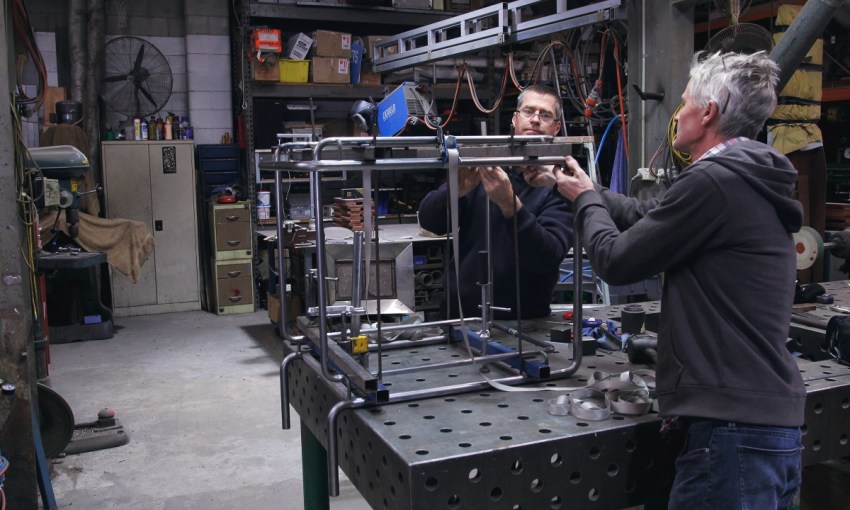Makers of all stripes have melded metal, warped wood and cut steel at George Street Studios for decades, but the studio is at risk of closure if the collective can't raise funds to secure a new location.
George Street Studios has to leave its Thebarton home
Nestled in the industrial heart of Thebarton, and conveniently located around the corner from the Wheatsheaf Hotel, is what resembles a pale blue house with a big shed hanging off the side.
But if you edge closer to the palm-tree-filled property, past two large bronze sculptures, a rotund rock and a mounted steel ‘g’, you will soon discover it is no ordinary house. The whirr of loud machinery and clanging tools soon reveals itself to be a workspace where artists turn their ideas into a tangible reality.
Tony Rosella is one of the original founders of George Street Studios (GSS) – a suburban art space offering tools and mentorship opportunities for visual artists, engineers, craftspeople, ceramicists and designers interested in the fabricated realm.
Tony has shuttled more than 50 craftspeople through GSS’ doors over two decades since its inception, with the collective responsible for creating a slate of the city’s most recognisable public works, such as the yellow liquid-like metal dripping off the facade of the Lion Art Factory, known affectionally as Custart; and the original and refurbished Kaurna Reconciliation Sculptures in the Adelaide Festival Centre’s forecourt on North Terrace.
But GSS could come to an end if the new vanguard of makers running the space fails to fundraise $33,000 in three months to secure it a new location. The money would pay the bond for a new leased city property and the purchase of equipment, such as a jig table, welders and cold saw.

Visual artist Eleanor Amor and her crack team of creatives – comprising Jake Shaw, Nat Penney, Jen Mathews, David McMurray and more – are behind the push.
“The lease is ending here and we are looking for a new venue,” Eleanor explains of the situation.
“But we are aiming to keep the legacy of George Street of having designers and craftspeople, engineers and artists working together in these spaces.”
The space’s founder, Tony, is an established practitioner himself. He plays with steel, granite and slate, and has been commissioned to make significant public artworks across the postcode 5000, such as the Vietnamese Boat People Monument with Ash Badios located along Karrawirra Pari / River Torrens.
But from within his GSS office, Tony tells CityMag he is calling it time on the collective. “I’m simplifying my life,” he says, alluding to wanting to strike more of a work-life balance and pumping the breaks on work. Without any animosity, Tony is passing the GSS baton on so it can be run by fresh faces.
This includes sculpture and installation artist Eleanor, who has been within GSS’ orbit for four years after landing a coveted Helpmann Academy-supported George Street Studio residency in 2019. She believes the collective is worth saving because it is unlike anything else in South Australia.
“George Street has been around long enough to have a reputation, and it’s worked with so many places, like the Adelaide Fringe, and like all these other institutions, and it is really hard to get spaces going like this,” Eleanor says.
“I think it came around in a time where the government and people were more excited about the arts but it has endured. We can’t lose it now.”
An example of the kind of success found at GSS is Kate Bohunnis, the winner of the 2021 $100,000 Ramsay Art Prize. Kate was another Helpmann Academy-funded George Street Studio resident in 2019, who stayed on in the space for an additional three years.
Kate made the award-winning work Edges of Excess at GSS, and tells CityMag the wealth of fabrication knowledge percolating in the Thebarton tin shed has “hugely impacted my practice.”
“The technical skills and material knowledge I have developed over this time will continue to benefit my work for years to come,” Kate, who identifies as non-binary, says.
“It is extremely rare to find a workshop that blends fabrication with experimental and contemporary art and even rarer again to find one that is welcoming to women and non-binary people.”
Jane McFarlane, CEO of the Helpmann Acadamy, tells CityMag that GSS is vital for Adelaide’s emerging artists because it offers a “dedicated studio, outside of an artist’s usual surroundings”.
“The artists we have supported, all comment on the generosity of ideas and skill sharing, the camaraderie and the incredible learning curve they have at George Street through their immersion into studio life,” she says.
Some of the magic that GSS forged won no awards.
Eleanor fondly recalls group activities, such as the Wobbly Chair Affair, where the multidisciplinary makers had an hour to fashion a stool out of unorthodox materials. They then had to sit on their said stools while they enjoyed a formal dinner, where “some chairs survived and some didn’t,” Eleanor says, laughing.
These moments were just as important as the accolades. It’s because it demonstrated when “people’s ideas become real,” she says.
“I feel like so many of us have had really ambitious ideas that couldn’t be actualised until we came to a space with people that have the maths brain to help us and make it happen.”




